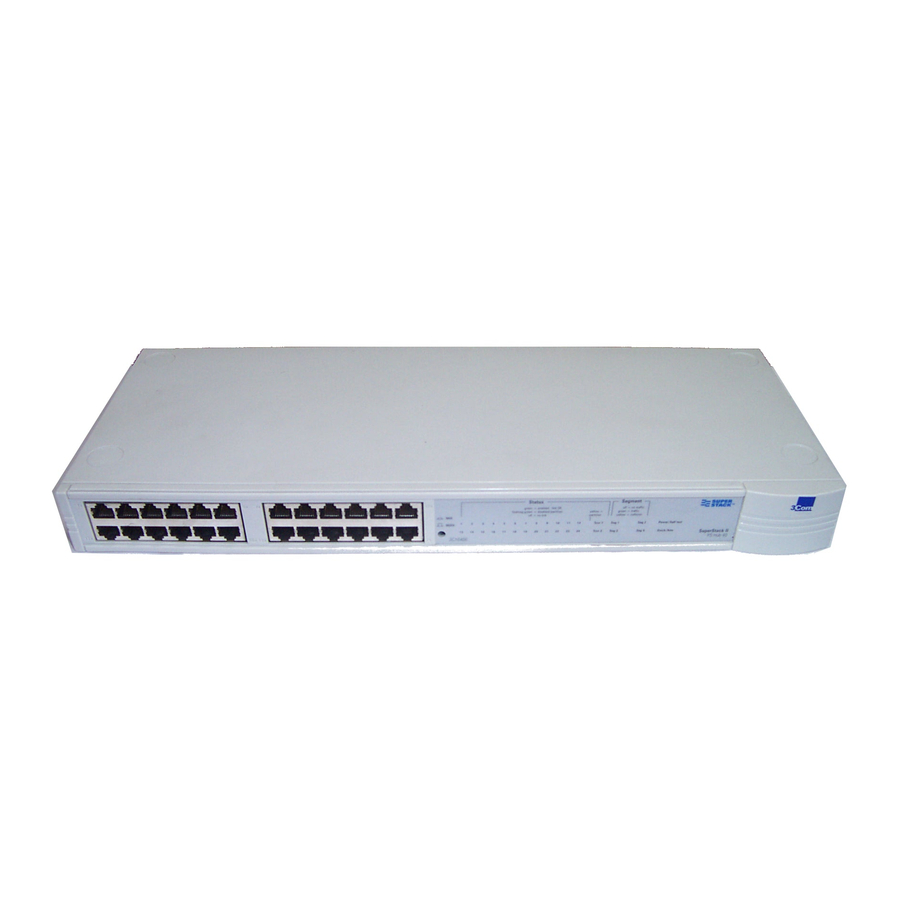3Com SuperStack II Manuel de l'utilisateur - Page 5
Parcourez en ligne ou téléchargez le pdf Manuel de l'utilisateur pour {nom_de_la_catégorie} 3Com SuperStack II. 3Com SuperStack II 9 pages. Switch matrix module
Également pour 3Com SuperStack II : Manuel de l'utilisateur (4 pages), Manuel de l'utilisateur (2 pages), Fiche complémentaire (1 pages), Important Information (2 pages), Manuel de l'utilisateur (6 pages)

WARNING: RJ45 ports. These are shielded RJ45 data
sockets. They cannot be used as telephone sockets. Only
connect RJ45 data connectors to these sockets.
AVERTISSEMENT: Les ports RJ45. Ceux-ci sont les prises
de courant de données RJ45 protégées. Ils ne peuvent pas
être utilisés comme prises de courant téléphoniques.
Brancher seulement les connecteurs RJ45 de données à ces
prises de courant.
WARNUNG: RJ45 Ports. Hierbei handelt es sich um
abgeschmirte RJ45 Datenbuchsen, die nicht als
Telefonbuchsen verwendbar sind. Nur RJ45
Datensteckverbinder an diese Buchsen anschließen.
10
MDI Switch (for port 14)
Ports 13 is fixed as an MDIX port so that it can be connected directly
to DTE which have MDI ports using normal 'straight through' TP
cables.
Port 14 is 'switch selectable' using the MDI Switch. The port can be
an MDIX port (to connect directly to DTE like port 13), or an MDI
port (to connect to other units using a normal 'straight through' TP
cable).
Out
In this position you can connect port 14 to a
workstation or any other DTE using a normal
'straight through' TP cable.
MDIX
In
In this position you can connect port 14 to any
MDIX port on a 10BASE-T or 100BASE-TX unit
MDI
using a normal 'straight through' TP cable.
To connect a 10BASE-T or 100BASE-TX unit to the Baseline Switch,
connect an MDIX port on the other unit to port 14 on the Baseline
Switch, as shown below. Ensure that the MDI switch on the Baseline
Switch is IN (MDI). If an MDI/MDIX port is used on the other unit,
ensure that the MDI switch for that port is OUT (MDIX).
11
Self-adhesive Pads
The Baseline Switch is supplied with four standard height and two
reduced height self-adhesive rubber pads. Usage of the feet depends
on where the Baseline Switch is placed:
3
Use the four standard height pads if the unit is to be placed
on a flat surface or stacked with another SuperStack II product
of the same dimensions.
3
Use the two reduced height pads and two of the standard
height pads if the unit is to be stacked on a SuperStack II unit
of different dimensions — Line up the front of the units, and
use the two standard height pads at the front (to fit the recess
of the unit beneath) and use the two reduced height pads at
the back.
Do not apply the pads if you intend to rack or wall mount
i
the unit.
If the unit is to be part of a free standing stack, apply the pads to
each marked corner area on the underside of the unit. Place the unit
on top of the lower unit, ensuring that the pads of the upper unit
locate with the recesses of the lower unit.
Positioning the Baseline Switch
CAUTION: When installing the Baseline Switch in a stack of
different size units, the Baseline Switch must be installed
above the larger units.
When deciding where to position the Baseline Switch ensure:
3
It is accessible and cables can be connected easily.
3
Cabling is away from:
3
sources of electrical noise such as radios, transmitters and
broadband amplifiers.
3
power lines and fluorescent lighting fixtures.
3
Water or moisture cannot enter the case of the unit.
3
Air flow around the unit and through the vents in the side of
the case is not restricted (3Com recommend that you provide
a minimum of 25mm (1in.) clearance).
To prolong the operational life of your units:
3
Never stack units more than six high if free standing, and
ensure that cables are supported so that they do not cause the
stack to fall over.
3
Do not place objects on top of any unit or stack.
3
Do not obstruct any vents at the sides of the case.
Rack or Wall Mounting
The Baseline Switch can be mounted in a 19-inch equipment rack, or
wall-mounted using the Mounting Kit. Refer to
Instructions"
.
Power Up
Use the following sequence to power up the Baseline Switch:
3
Check the network connections and cables.
3
Connect the power supply cable to the appropriate power
socket on the rear panel of the unit. Refer to 7 or 8.
3
Connect the plug to the power supply outlet socket and
switch on the power supply at the socket. If you are using the
Advanced Redundant Power System, ensure that it is switched
on.
When the Baseline Switch is powered on, the Power LED should be
lit. If it is not, refer to 6.
Spot Checks
At frequent intervals you should visually check the Baseline Switch.
Regular checks can give you an early warning of a possible failure;
any problems can then be attended to when there will be least
effect on users. Check the following:
Cabling
Check that all external cabling connections are
secure and that no cables are pulled taut.
Cooling fans
Check that the cooling fan is operating by
listening to the unit. The fan is fitted near to
the front right hand side of the unit (when
viewed from the front).
What To Do Next?
If the Baseline Switch fails to operate successfully, contact your
supplier with the following information before returning the unit:
3
product number and serial number
(printed on a label on the bottom of the unit)
3
a brief description of the fault
When returning any equipment to your supplier ensure that the
equipment is packed suitably for transit.
4
"Mounting Kit
